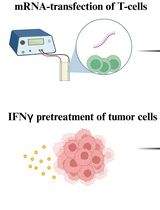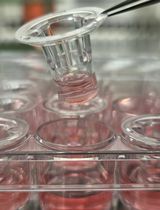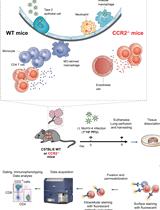- EN - English
- CN - 中文
High-Efficiency Retroviral Transduction for Type 1 Regulatory T Cell Differentiation
高效逆转录病毒转导用于1型调节性T细胞分化
发布: 2022年09月05日第12卷第17期 DOI: 10.21769/BioProtoc.4499 浏览次数: 2606

相关实验方案

基于 T 细胞的平台,用于对肿瘤浸润 T 细胞的单细胞 RNA 测序数据集中鉴定的 T 细胞受体进行功能筛选
Aaron Rodriguez Ehrenfried [...] Rienk Offringa
2024年04月20日 6229 阅读

研究免疫调控血管功能的新实验方法:小鼠主动脉与T淋巴细胞或巨噬细胞的共培养
Taylor C. Kress [...] Eric J. Belin de Chantemèle
2025年09月05日 3412 阅读
Abstract
Type 1 regulatory T (Tr1) cells are an immunoregulatory CD4+ Foxp3- IL-10high T cell subset with therapeutic potential for various inflammatory diseases. Retroviral (RV) transduction has been a valuable tool in defining the signaling pathways and transcription factors that regulate Tr1 differentiation and suppressive function. This protocol describes a method for RV transduction of naïve CD4+ T cells differentiating under Tr1 conditions, without the use of reagents such as polybrene or RetroNectin. A major advantage of this protocol over others is that it allows for the role of genes of interest on both differentiation and function of Tr1 cells to be interrogated. This is due to the high efficiency of RV transduction combined with the use of an IL10GFP/Foxp3RFP dual reporter mouse model, which enables successfully transduced Tr1 cells to be identified and sorted for functional assays. In addition, this protocol may be utilized for dual/multiple transduction approaches and transduction of other lymphocyte populations, such as CD8+ T cells.
Keywords: Retrovirus Transduction (逆转录病毒转导)Background
Type 1 regulatory T (Tr1) cells are an immunoregulatory Foxp3- CD4+ T cell subset that is able regulate inflammation and induce tolerance, making them a promising candidate for immunotherapies (Mobs et al., 2010; Gol-Ara et al., 2012; Roncarolo et al., 2014; Bohm et al., 2015). Therefore, signaling pathways and transcription factors regulating Tr1 differentiation and suppressive function are of great clinical interest. RV transduction of CD4+ T cells has been an effective tool in this endeavor (Wu et al., 2013; Mascanfroni et al., 2015; Karwacz et al., 2017). Many studies use Tr1 differentiation as an endpoint because detection of IL-10 and Foxp3 require terminal methods, such as fixation of cells. As a result, signaling pathways and transcription factors regulating the suppressive function of Tr1 cells are less understood than those required for differentiation. This protocol was developed to investigate the role of signaling pathways and transcription factors downstream of TCR/ITK, which regulate both Tr1 differentiation and suppressive function (Huang et al., 2017). The use of an IL10GFP/Foxp3RFP dual reporter mouse model, high efficiency of RV transduction, and bicistronic retroviral vectors that enable transduced cells to be identified via expression of a reporter gene allows sufficient numbers of live transduced Tr1 cells to be isolated for functional assays. Another advantage of this protocol is that it does not make use of chemical transduction enhancers, such as RetroNectin or polybrene, which may be cost-prohibitive and cause cytotoxicity (Kurachi et al., 2017; Eremenko et al., 2021). In addition, the protocol described here may also be utilized for dual transduction strategies and other lymphocyte populations, such as CD8+ T cells.
Materials and Reagents
Eppendorf® Safe-Lock microcentrifuge 1.5 mL tubes (Sigma-Aldrich, catalog number: T9661)
70 μm Cell Strainer (Vita Scientific, catalog number: NSTF90051)
CytoOne T75 filter cap TC flask (USA Scientific, catalog number: CC7682-4875)
100 mm Dish, Tissue Culture-Treated (VWR, catalog number: 25382-428)
Corning® 96-well Clear Flat Bottom Polystyrene TC-treated Microplates (Corning, catalog number: 3596)
0.45 µm Sterile Polyethersulfone Syringe Filter (VWR, catalog number: 28145-493)
10 mL BD Luer-LokTM Syringe (BD, catalog number: 309605)
Axygen 96 Well Clear V-Bottom 550 µL Polypropylene Deep Well Plate (Axygen, catalog number: P-96-450V-C)
IL10GFP/Foxp3RFP dual reporter mouse model (generated as we previously reported in Huang et al., 2017)
Rag-/- mouse model (Jackson Laboratory, Strain #: 002216)
Note: All animal experiments were approved by the Institutional Animal Care and Use Committee (IACUC) at the Louisiana State University (protocol #: 18-047 and 21-039).
MS Columns (Miltenyibiotec, catalog number: 130-042-201)
LS Columns (Miltenyibiotec, catalog number: 130-042-401)
InVivoMAb anti-mouse CD3ϵ [clone: 145-2C11] (Bio X Cell, catalog number: BE0001-1)
InVivoMAb anti-mouse CD28 [clone: 37.51] (Bio X Cell, catalog number: BE0015-1)
Mouse IL-27 (NS0-expressed) Protein (R&D Systems, catalog number: 2799-ML-010)
Retro-XTM Concentrator (Takara Bio, catalog number: 631456)
Opti-MEMTM, Reduced Serum Medium (Thermo Fisher Scientific, catalog number: 31985070)
Mirus Bio TransIT®-293 Transfection Reagent (VWR, catalog number: 10766-968)
Plat-E cells, a retrovirus packaging cell line described in Morita et al. (2000)
Bicistronic retroviral vector (e.g., pGC-IRES-Thy1.1, pMI-IRES-hCD2, pGC-IRES-BFP2. See Acknowledgments for details).
RPMI 1640 Medium (Fisher Scientific, catalog number: 11-875-119)
DMEM (Fisher Scientific, catalog number: 11-965-118)
Fetal Bovine Serum (Thermo Fisher Scientific, catalog number: 10082147)
1 M HEPES solution (Cytiva, catalog number: SH30237.01)
100× Nonessential Amino Acids (Corning, catalog number: 25-025-ci)
100 mM Sodium Pyruvate (Hyclone, catalog number: sh30239.01)
200 mM L-Glutamine (Hyclone, catalog number: SH30034.02)
100× Penicillin/Streptomycin Solution (Hyclone, catalog number: SV30010)
Puromycin dihydrochloride (Sigma-Aldrich, catalog number: P7255)
Blasticidin S.HCl Solution in HEPES buffer 10 mg/mL (A.G. Scientific, catalog number: B-1247-SOL)
Red Blood Cell (RBC) Lysis Buffer (10×) (Tonbo Biosciences, catalog number: TNB-4300)
Anti-biotin Microbeads (Milteny Biotec, catalog number: 130-090-485)
Mitomycin C (CAS 50-07-7) (Santa Cruz Biotechnology, catalog number: SC-3514B)
3% Acetic Acid with Methylene Blue (StemcellTM Technologies; catalog number: 07060)
Biotin Anti-human/mouse CD45R (B220) [clone: RA3-6B2] (Tonbo Biosciences, catalog number: 30-0452)
Biotin Anti-CD19 monoclonal antibody [clone: HIB19] (Thermo Fisher Scientific, catalog number: 13-0199-82)
Biotin Anti-CD8α rat monoclonal antibody [clone: 53-6.7] (Biolegend, catalog number: 100704)
Biotin Anti-mouse TER-119 [clone: TER-119] (Tonbo Bioscience, catalog number: 30-5921)
Biotin Anti-CD49b (pan-NK cells) rat monoclonal antibody [clone: DX5] (Biolegend, catalog number: 108904)
Biotin Anti-NK1.1 [clone: PK136] (Tonbo Bioscience, catalog number: 30-5941)
Biotin Anti-TCRγδ [clone: GL 3] (eBioscience, catalog number: 13-5711-85)
Biotin Anti-Ly-6G/Ly-6C (Gr-1) rat monoclonal antibody [clone: RB6-8C5] (Biolegend, catalog number: 108404)
Biotin Anti-mouse CD122 (IL-2Rβ) [clone: 5H4] (Biolegend, catalog number: 105904)
Biotin Anti-CD25 rat monoclonal antibody [clone: PC61] (Biolegend, catalog number: 102004)
Biotin Anti-CD44 rat monoclonal antibody [clone: IM7] (Biolegend, catalog number: 103003)
Biotin Anti-CD11b rat monoclonal antibody [clone: M1/70] (Biolegend, catalog number: 101204)
Biotin anti-CD11c monoclonal antibody [clone: 3.9] (Thermo Fisher Scientific, catalog number: 13-0116-82)
Biotin Anti-mouse F4/80 [clone: BM8] (Biolegend, catalog number: 123106)
Ghost DyeTM Violet 510 (Tonbo Biosciences, catalog number: 13-0870-T100)
FITC Anti-mouse TCRβ [clone: H57-597] (Tonbo, catalog number: 35-5961)
Phycoerythrin (PE) Anti-mouse CD25 monoclonal antibody [clone: PC61.5] (Tonbo Biosciences, catalog number: 50-0251)
Allophycocyanin (APC) Anti-CD4 rat monoclonal antibody [clone: GK1.5] (Biolegend, catalog number: 100412)
PE-Cy7 Anti-CD62L rat monoclonal antibody [clone: MEL-14] (Tonbo Bioscience, catalog number: 60-0621-U100)
Pacific BlueTM Anti-human CD2 (hCD2) antibody [clone:TS1/8] (Biolegend, catalog number: 309216)
PE Anti-rat CD90/mouse CD90.1 (Thy-1.1) antibody [clone: OX-7] (Biolegend, catalog number: 202523)
Full DMEM (see Recipes)
Full DMEM + Puromycin/Blasticidin (see Recipes)
Full RPMI (see Recipes)
1× RBC Lysis Buffer (see Recipes)
Primary biotin antibodies master mix (see Recipes)
Magnetic anti-biotin microbeads + sorting antibody master mix (see Recipes)
Equipment
LSR Fortessa X-20 (BD Biosciences)
FACS Aria II Cell Sorter (BD Biosciences)
Avanti J-15R Centrifuge (Beckman Coulter)
Eppendorf Centrifuge 5420 (Eppendorf AG)
MACS® MultiStand (Miltenyi Biotec, catalog number: 130-042-303)
FormaTM Series 3 Water Jacketed CO2 Incubator (Thermo Fisher, catalog number: 4110)
Software
FlowJo (FlowJo, LLC)
FACS DIVA software version 9.0 (BD Biosciences)
GraphPad Prism (GraphPad Software)
Procedure
文章信息
版权信息
© 2022 The Authors; exclusive licensee Bio-protocol LLC.
如何引用
McGee, M. C., August, A. and Huang, W. (2022). High-Efficiency Retroviral Transduction for Type 1 Regulatory T Cell Differentiation. Bio-protocol 12(17): e4499. DOI: 10.21769/BioProtoc.4499.
分类
免疫学 > 免疫细胞功能 > 淋巴细胞
生物工程 > 生物医学工程
细胞生物学 > 细胞工程 > 慢病毒递送
您对这篇实验方法有问题吗?
在此处发布您的问题,我们将邀请本文作者来回答。同时,我们会将您的问题发布到Bio-protocol Exchange,以便寻求社区成员的帮助。
Share
Bluesky
X
Copy link










